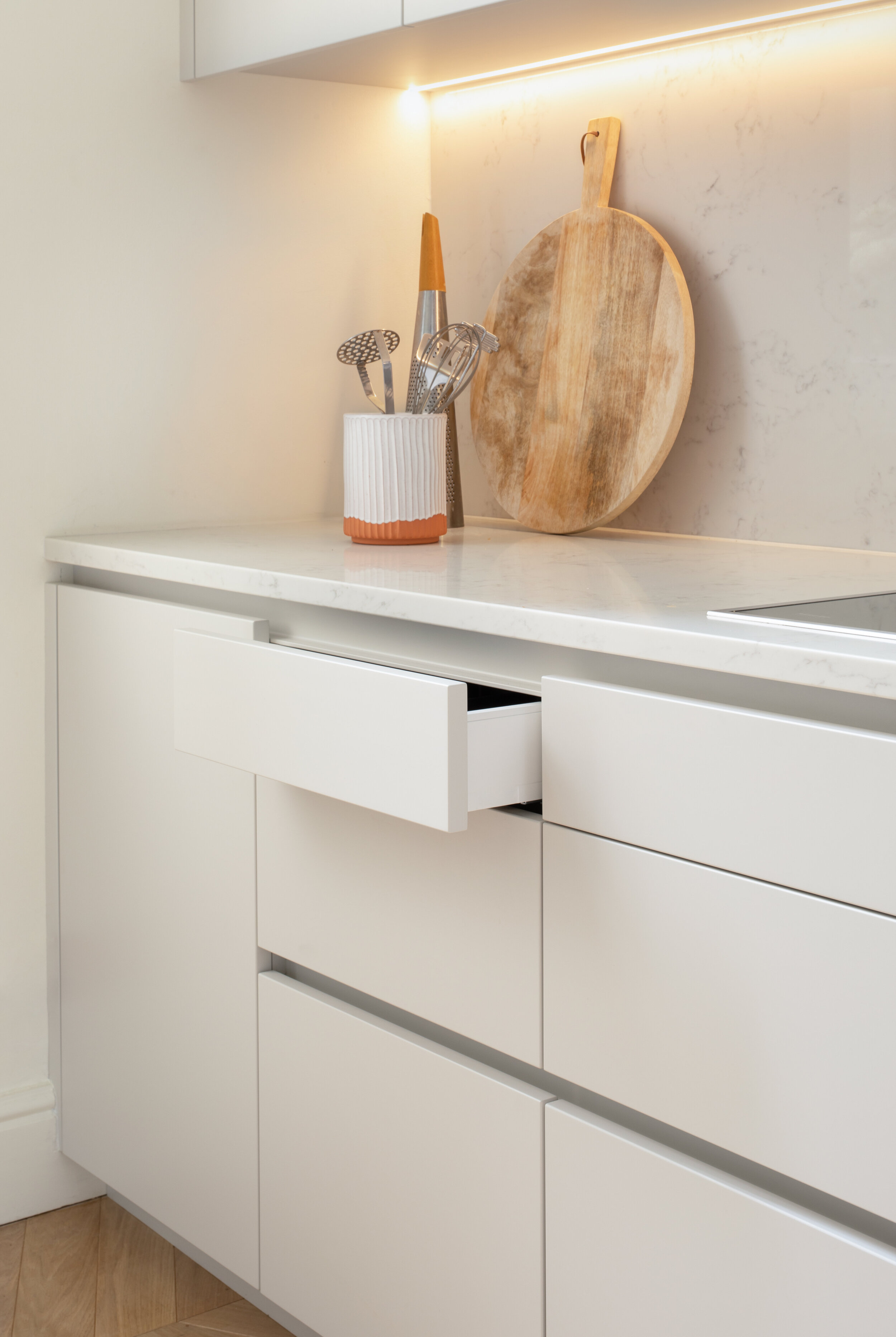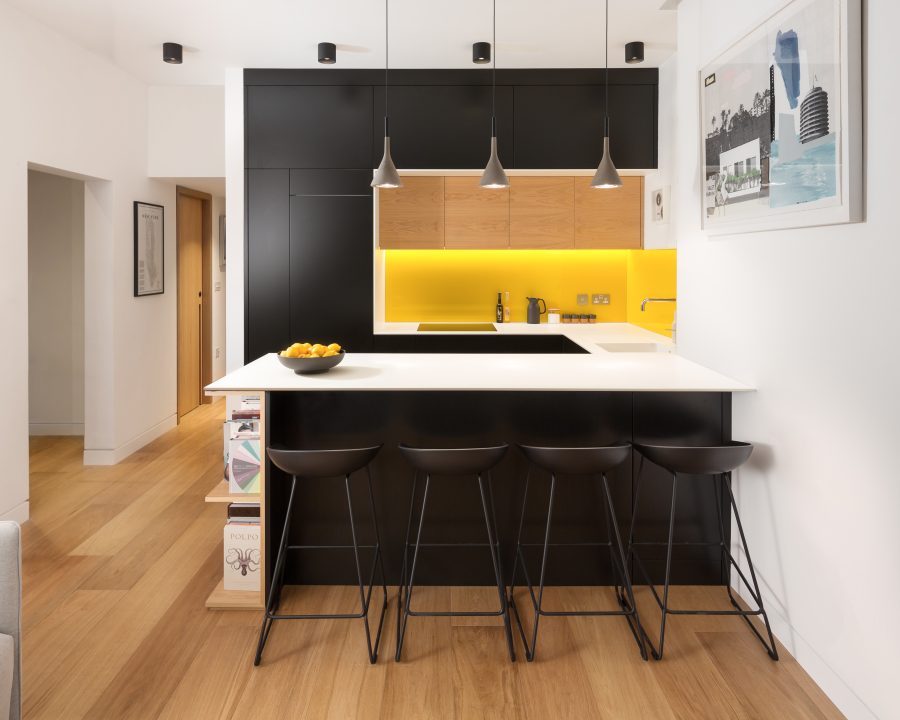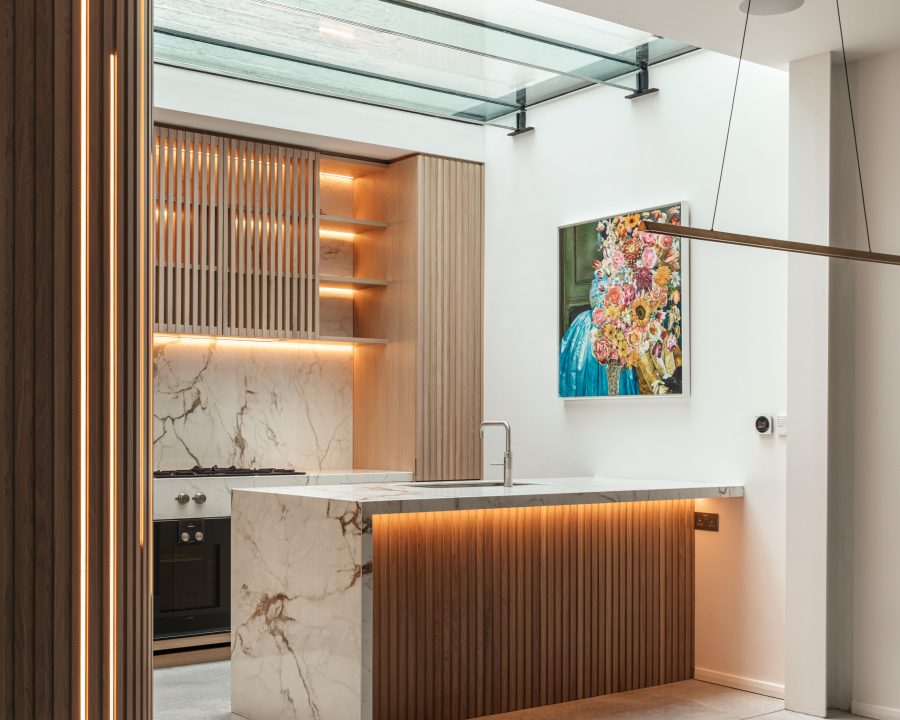
Industry Insights: Handle Details
Handle Details
There is a large variety of handle options available when considering the overall aesthetic of your new cabinetry. Whilst we often use fixed, off-the-shelf handles (our favourite contemporary styles are from Furnipart, Dowsing and Reynolds or Buster + Punch, whilst for a more classic look we most often use Armac Martin or Joseph Giles), we wanted to give you a brief introduction into some of the types of integrated handles our skilled team creates in our London workshop.
Whilst integrated handles are often used in ‘handleless’ kitchen designs, we love to incorporate them into a variety of styles of cabinetry, be this from the sleek, contemporary styles, to a more classical look, perhaps with contrasting timber detailing. The handle is often the first part of the joinery that you touch, and we feel that it should therefore be an integral part of the design, with everything from the form to the material choice being considered.
Read on for a quick run down of the handle styles we most frequently use & love, both in the kitchen and throughout the house.

Handleless
Counter-intuitively, even in a handleless design, the handle details must still be considered to achieve the best functionality from a space. Whilst there are a variety of options available to create the handleless look, we are led by what the intended use or function of the cabinet will be. Some of the solutions we use most frequently include methods such as overhanging doors, opened from the bottom, as we did for the wall cabinets of The Lunar Kitchen. For the lower level drawers, to complete the look, we used a recessed Gola profile, powder coated to match the cabinetry, creating a harmonious aesthetic.
Another method for achieving a handleless look is to use Blum Tip-on, or push-to-open catches, however the size of the door should be taken into account when using hardware such as this.



Recessed/Finger Grooved
A recessed finger pull, often referred to as either of the above, can come in a variety of forms. The most common is a J-shaped groove, cut into the top or side of the door or drawer front, which, when routed, is always in the same matching material as the cabinetry. When a standard J-groove and matching finish is used this is a subtle choice for a handle detail, however it offers guaranteed practicality and ease of use, and when fabricated well are satisfying to the touch and effortlessly stylish in appearance.
A beveled edge can also be used to create a recessed handle detail, often book-ended on the bottom of a top drawer next to the top of a middle drawer to combine to make a new detail. We used an angled drawer front combined with a contrasting timber panel in the kitchen of The Courtyard House, where you can see a beveled edge on the top allowing the drawer to sit snugly against the worktop, and a coordinating recessed finger pull on the bottom, allowing you to open both the top and lower drawers from the same plane. Using the handle details to allow the contrast of the timber detail to show through can create a striking aesthetic, which can be both modern or more traditional, depending on the combination of spray colour and timber chosen.


Rebated/Inset
Building on the contrast of materials introduced in the recessed handle detail section, a rebated or inset handle can also offer this contrast of materials, however with additional materials being integrated into the handle itself. Although very similar in its composition to a recessed handle, a rebate is where a groove is cut into a plane that allows a secondary item or material to sit flush within it. When designing a rebated handle, we often use contrasting materials to create a statement detail that shows off the handle rather than allowing it to blend into the cabinetry. This is demonstrated in The Ladder Kitchen, where a brass inset handle is rebated into the face of the cabinetry creating a bold industrial aesthetic, contrasting the feminine colour palette.
In the Lambeth Marsh kitchen a recessed handle detail (on the centre and left cabinets) is combined with a coordinating rebated handle on the right hand cupboard, creating the illusion that the timber panel runs across the width of all three units. Other examples of a rebated handle can be seen in the bedrooms of the Signal House, where a Natural Oak panel is rebated into the back of an angled finger pull detail to coordinate the exteriors of the cabinetry with the Oak interiors.


Cut-Out
A cut-out handle detail is perhaps the simplest detail from a technical standpoint, however it can be high-impact depending on the design. When creating a cut-out handle detail, a shape is simply cut through the entire thickness of the cabinetry, either at the edge, in for example, a crescent handle detail, or on the face of the door or drawer. Alternatively, a door or drawer front can simply not reach the full height of the cupboard or drawer, leaving a void that acts as a handle, and creates a minimalist aesthetic. A primary shape punched throughout the face of a door or drawer can be a playful design feature when creating cabinets for children, as they can enhance and stimulate their environment for learning. In The Etch House, we took this principle a step further by punching windows that multitask as handles in the cabinetry for the children’s playroom. For a more grown-up look, contemporary shapes can be carved through the face of the door or drawer, creating a sleek and practical handle.

Scalloped
The final detail we would like to share with you is a scalloped handle, most frequently used on sliding doors, although they can also be implemented into cabinets with smaller doors where you do not need to gain excessive purchase on the surface to open it. A scalloped detail is carved into the plane of the door or drawer front, creating a shape that can either be finished to match the main surface, or have a contrasting material inset into it. This is demonstrated in the sliding doors on the upper floors of The Etch House, where a hexagonal scalloped handle detail is highlighted by the patinated brass detail that we etched on our CNC machine.
There is a huge variety of options for detailing handles, and whilst we have attempted to categorise those that are most frequently seen, in truth most handle details bridge multiple categories or do not neatly fit into one at all. When we design a cabinet, we take the overall aesthetic of the cabinetry into consideration along with the necessary practicalities in terms of usability, combined with our client’s stylistic preferences, to design a unique handle solution, perfectly suited to the bespoke nature of that particular unit. As such, you will rarely see the exact same handle being used across different projects, as the best solutions are often as unique as the end user they were designed for.

If you have any questions on what we discussed here, or would like to get in touch with us to discuss your own bespoke project, get in touch with us via the button below.
Seen an amazing handle detail out in the wild? Tag us via our socials below!















